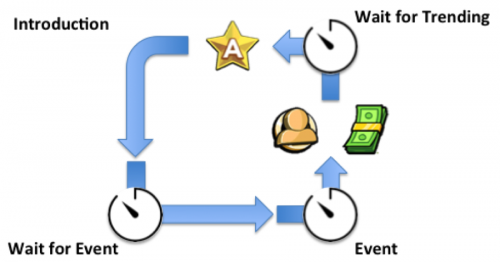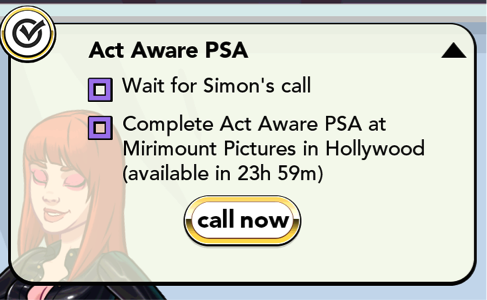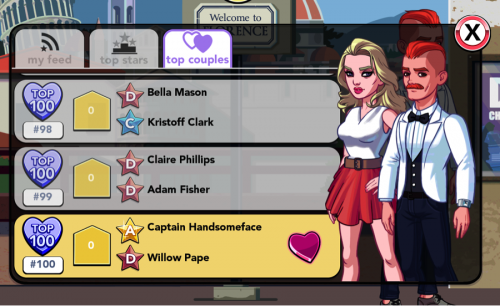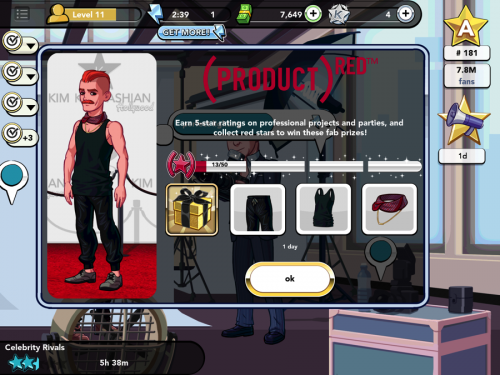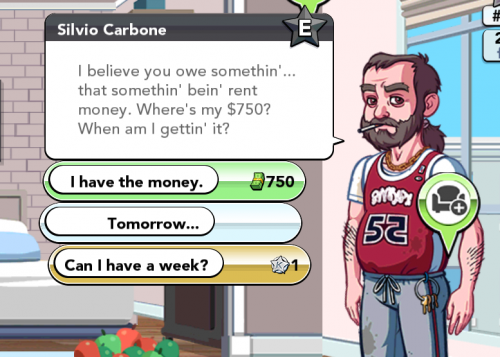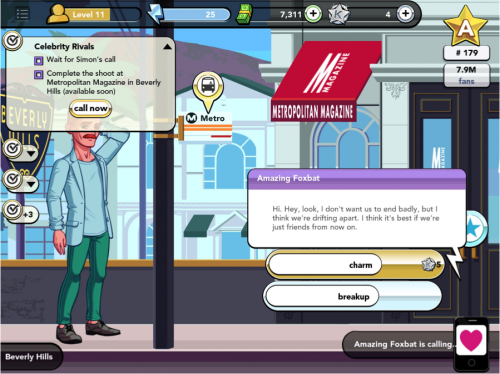Gameplay Analysis of Kim Kardashian: Hollywood
Joe Traverso, Activision’s lead project manager, analyzed in detail the pros and cons of the gameplay of the popular Kim Kardashian: Hollywood game. We have translated his text and are sharing it with you.
I’m sure you’re familiar with the phenomenon of Kim Kardashian: Hollywood – unless you’ve spent the last couple of months on a desert island. Even if you haven’t played the game, you’ve definitely heard of it.
Kim Kardashian: Hollywood:
- inspired a lot of detailed critical reviews;
- launched a discussion about the value of intellectual property in the industry;
- this is one of the biggest game releases of the past year, no matter how you look at it;
- it’s a franchise.
We are not going to talk about any of these aspects here. We are going to take apart Kim Kardashian: Hollywood (hereinafter – KKH) to understand how it works. Considering all the hype around the project, you probably think that there is some magic in the game that explains the retention and attraction of users. In fact, yes – there is magic. Just not the type of magic that can be easily copied to repeat success. The game is simple, with simple F2P mechanics that have been used since FrontierVille or even earlier.
For all its simplicity, KKN, meanwhile, is getting its way in the field of style. In addition, she is firmly made and correctly uses the Kim Kardashian brand. The Glu team has created a mobile game that has attracted a completely new audience. Without a combination of these components – audience, license and mechanics – the game would not have had the success that we are witnessing (and who does not know this, as Glu itself, because KKN is a reskin of the game Stardom: Hollywood, also a good project by many indicators. But he is far from Kim’s success).
Thus, a closer look at the mechanics of Kim Kardashian is very informative, but it is important to remember that it will be very difficult to repeat the success of this game without the same license.
Game cycle
The success of the game is built around a simple game cycle. Performing actions in the game – from taking photos to walking on the podium – requires energy. Different tasks take different amounts of energy, which gives the player space to plan in the daily game (“How many actions will I have time to complete with the remaining energy?”). These tasks generate energy points and soft currency for the player- and in addition, some context-dependent resources, which we will return to in the “Retention” section. The measure of energy increases with the level of the player – that is, the longer the user plays, the more actions he can perform.
Retention
In shareware games, the basis of retention is a bright main goal. It should be relevant for the CA. It is complemented by medium-term goals – they look achievable, but at the same time they are far enough away that you have to constantly invest in them. These medium-term goals are achieved by completing understandable short-term game tasks that reward the player on an ongoing basis for participation. Short-term achievements are guided by a strong game cycle and a balanced game economy, and the strong retention of the first day is explained by the tutorial, which shows all the attractive sides of the game and at the same time gives the user the basic skills to achieve success.
To make it clearer, I will show the scheme of the conditional game, and explain again exactly how the KKN meets all the requirements.
In this game I am
To
What helps me achieve
And this gives me
Let’s fill out this scheme for KKN:
In this game, I use energy to perform actions
To complete quests and level up
What helps me discover new locations and cities
And it gives me the opportunity to become an A-list celebrity.
The goal for the KKN game is described in clear and understandable images and supported by medium-term goals. These goals are achieved with the help of clear short-term achievements and a strong game cycle. The tutorial of the game presents all its components and at the same time prepares the ground for the plot of the game, which in the form of a quest forces the player to join the list of celebrities of the D list.
For all these reasons, it is clear why the game has a strong hold on the first day and a good short-term hold (on day 7-14).
Game cycle. Drain counted
There is one thing that distinguishes KKN from similar F2P games. This is the lack of an opportunity to “merge” soft currency in the game cycle. Most modern shareware titles include in their game cycle the opportunity to quickly spend soft currency in order to balance the game economy. Here are some examples of how other successful games “drain” the game currency during the game cycle.
- Hay Day: Players must spend soft currency to purchase new animals, trees, animal buildings and farm buildings in order to finish other houses and earn XP.
- Puzzles and Dragons: Players spend soft currency to strengthen and improve the team so that they can fight in more difficult dungeons.
- Clash of Clans: Players must spend soft currency on building and improving buildings, as well as creating new soldiers, in order to remain competitive in PvP.
As we have already said, a well-balanced gaming economy is one of the key points of retention. Why? The longer the soft currency balance is maintained in the game, the longer the player will interact with the game cycle to progress in the game. As soon as the player no longer has to interact with the game cycle to progress, as soon as he can enter the game and immediately use soft currency to buy any new content, he will play the game much less and as a result will leave.
But if KKN does not merge soft currency during the game cycle, then what is its long-term user involvement based on? The answer is that a soft currency is one of the three types of currencies that can be earned while in the game cycle. The other two types – “blue stars” and “pink hearts”, or the currency acquired with progress – that’s who drives the improvement of the player.
Let’s see how this progress currency differs from a soft currency.
They are deleted: every time a player needs to collect blue stars or pink hearts, his balance of this resource starts from zero.
They can’t be used another time: they are only suitable for a certain event, quest, and so on – during which they were earned.
They depend on the content: the player gets nothing but progress from what they gain.
They guarantee progress: asterisks are converted into promotion to the top of the A-list, and hearts are converted into promotion to the top of the “Best Couples” list.
The duration of the process is unclear to the player: the player does not know exactly how many actions will be required each time to fill in the measure of hearts or stars – the developer is sitting at the control panel.
As a result, each event of the game has its own micro-economy, which involves the player in the game cycle as if he starts from the beginning every time! This is how KKN gracefully overcomes the issues of setting up the balance of a soft currency, despite the fact that there are few drains in the game cycle. The player can use it to “jerk” – which guarantees a small progress in each case (this is a single “golden heart” in the picture above) and at the same time does not destroy the involvement in the game.
Short-term achievements. Quests
Someone has to say this: KKN is probably the most well-written mobile game of all time. We must pay tribute to the game scriptwriters for accurately recreating the tone and vocabulary of Millennials, who make up the main audience of the game.
The story is a very important component of retention in story games, because it is it that catches the player and allows him to move towards his medium-term goals, as well as to the main goal. In KKN, the plot is transmitted through a series of quests that lead the player’s short-term progress.
One of the challenges that the creators of quest games face is to find the right rhythm for introducing new plots into the game. To add a new quest, you need to first write it, then configure it, then QA should test it, Apple should accept it – and so on. During this time, the players involved already manage to skip all the available quests at high speed. Sometimes, in an attempt to keep up with these fiercely playing (and paying) players, the quality of the content suffers.
Another difficulty is that hundreds of new quests in the game, which are added every week, can scare off a new player or an uninvolved player. These comrades may be scared by five or more new active quests – they will just get upset and leave.
Glu solved the problem with a quest design system.
Two quests in one
The KKN quest system is, in fact, two systems in one. The first is the author’s content. These quests are created by designers and screenwriters, they are introduced into the game in the usual way, which is already described above. They drive the game’s plot forward and help players stay motivated in achieving their medium- and long-term goals.
Another quest system is a quest aimed at grinding. The location, type of work and time of passage in it are combined with each other automatically. The player can choose the time of passage, and he also has the opportunity not to choose any of the proposed quests, and in this case he will have to wait (or pay) to choose another grind quest.
The player receives such quests in the same way as the author’s, so the difference is almost invisible to him.
This system solves a lot of problems that quests suffer from.
Fills the time between the creation of new content: automatically created quests fill the time between the “chapters” of the main plot, which means that developers need to create less expensive author content
Allows the player to choose: the system allows the player to choose their own goals, so that the game is, as it were, tailored to the individual style of play
Uses existing content: these quests reuse older locations, which pushes back the need to create new ones in time.
On-demand quests: One of the quest systems goes into the background when there is a need to follow the plot – and this prevents the player from unnecessarily using non-plot content
Using a two-quest system, KKN supports user engagement with less author content.
Timers, timers, timers!
There are a lot of timers in KKN. Despite the fact that there are several quest formats in the game, most consist of four phases:
- introduction: a dialogue that heats up the motivation of the player to participate in the quest;
- waiting for an event: the time between the presentation and the start of the event;
- event: there is a game cycle going on here;
- Waiting for results: After the end of the event, the player must wait to find out how many fans he has gained or lost.
Timer One – Waiting for an event
This timer stretches the duration of the quest by one and a half times, on the one hand, increasing the content of the game, and on the other – adding another opportunity to get money from an impatient paying player. This timer would not work without a grind quest – in this place, players would have nowhere to waste energy, so their daily sessions would be reduced. This is where the two-quest system comes into play.
The second timer. Event
This timer forces the player to play many times a day, increasing his involvement in the game cycle. If a player cannot complete this phase in one approach (using one measure of energy), he will either have to wait until the energy is replenished to continue, or spend hard currency to buy energy. If she does not return before the timer runs out, then he faces the risk of losing fans due to failure to complete the quest. If there was no timer, the player would have no motivation to return to the game to spend the replenished energy.
You may wonder: “Why not give the player the opportunity to skip the timer?”. Remember, this is the only part of the quest in which the player interacts with the game cycle, so skipping it means skipping the “game” part of the game. Involvement in the game cycle is closely related to long-term retention, so it is very important not to let the player escape the game cycle due to higher monetization.
This phase embodies the concept of “negative encouragement” in the game. If a player does not get at least three stars, then he risks losing fans and progress towards the A-list. This is a good motivation to earn all five stars by playing numerous sessions during a three-hour or more event.
The timer is the third. Waiting for the results
This is probably the most interesting timer of the three. Once the event is over, the player must wait for the “trends” to appear to find out how many fans he has added (or lost).
Here you need to think about where the player is at the start of the third timer.
Option one – the player returned the game on time and completed the quest at 100%, while spending some energy.
Option two – the player returned to the game at the moment when the timer ended.
In the first case, the player does not have a full measure of energy, and therefore he may not want to start a new quest. In this case, without this third timer, the player will not have active timers. This means that there is no need for him to return to the game – there will be no notifications, no feeling that he is missing something. So the third timer plays a role in the mechanics of holding the next day.
In the second case, the player most likely has a full or almost full measure of energy. He screwed up the quest and will soon lose fans, which means that he is making progress towards the top of the A-list.
If in this case you immediately tell the player that he has already lost fans, then he can close the game out of frustration and will not use the accumulated energy, which means that the first timer will not start again. By telling the bad news to the player a little later, you give him time to try to earn some lost progress again and re-engage with the game cycle before the session ends.
Medium-term goals. New locations and cities
New locations and cities are most likely the most expensive content that KKN developers have to create. The whole game takes place either in locations or on city maps, so a change of scenery – along with a developing plot – allows the game to remain interesting to users. This is important, given that the game cycle does not change.
New locations and cities, however, are added to the game less often. They are also the most difficult to achieve. At the time when this material was created, there were 10 cities in the game – compare this with four cities at the time of the launch of the game. Yes, the player gets into the coveted A-list faster than he opens all the cities!
Cities open after reaching the next level. The player has to grind, and for quite a long time to open them all. Some streets open only after completing certain quests, so the player will not only have to interact with the game cycle, but also follow the plot if he wants to see all the content that is in the game.
Goal
The ultimate goal of the game is to get into the number of celebrities from the A-list. It is very clearly marked and understandable to both Kim’s fans and ordinary players.
Let’s look back and see how the game level by level leads the player to his goal.
The game explains in the most understandable way what will lead to the cherished goal – take actions to get stars, get stars to complete quests, complete quests to acquire fans, acquire fans to climb up to the A list. Simplicity is the main reason why the game was able to attract a new audience, and, more importantly, to hold her.
Of course, one can’t help but wonder – what happens when a player does get on the A-list? Unlike other quest games, it will not work to add new tasks to this one: if you invent a new star list specifically for the players, it will destroy all the credibility of the game.
How does Glu try to solve this problem? Two ways:
Splitting List A
Once you have reached the goal, the focus of the game changes. Now you need to get into the top 100 to eventually become a star of the first magnitude. This forces the player to continue climbing up – and, therefore, provokes interaction with the game cycle.
The disadvantage of this method is that in the end the player will still become the number one star. Of course, Glu will add new stars to the top of the list. Here the risk is already that the player may think that the goals will be moving away from him. This will inevitably force him to quit the game, since it is basically impossible to “finish” it.
And this brings us to the second way.
New goals
Since its launch, Glu has added two new goals to the game – one temporary and one permanent. Both are designed to keep the player tied to the game cycle for as long as possible.
“The best couples”
At the time of launch, the “Romance” system looked far-fetched. Of course, there were quests that encouraged the player to find his love, but there was no special interest in it – just measurements that need to be filled in.
With the latest update, the situation has improved. Now “Romance” is similar to the “Best Couples” system and complements it.
Despite the fact that they are both as effective as the “Top Stars” in terms of attracting users and involving them in the game cycle, their main drawback is that they are not directly tied to the quests of the game, and, therefore, the main progress does not depend on them. Glu has tried to solve this problem, but so far without success.
In addition, those players who have not yet reached the top of the A-list, the “Best Couples” chart is confusing. Choosing between getting into the stars of the first magnitude or between becoming one of the “Best couples”, the player will certainly choose the first.
Stocks
Glu has followed in the footsteps of almost every successful casual F2P game and added promotions to KKN. So, what is a suitable system with shares?
Economy: the player’s resources are reset before a new promotion, which gives everyone the opportunity to compete on an equal footing and does not allow paying players to skip the promotion.
Reward Levels: Gives uninterested users a sense of completion of the process, while encouraging them to participate in all sessions to collect all the rewards.
Competition: Forces whales to pay to stay in first place – thereby stimulating all new payments.
Timers: the fact that the stock has a short “shelf life” increases engagement, and – in the long run – frees up space for future promotions.
We use this scheme to find out how it corresponds to the action (RED), in which the game took part in early December.
Economy: yes
“Red stars” were added to the game specifically in honor of the event, which the user can get only by re-interacting with the game cycle
Levels with rewards: there are
At each level, there is a new prize, which gives low-level users achievable goals, and, at the same time, allows involved users and paying players to grind in order to get, for example, a certain scarf, which will be the finishing touch in the ensemble.
Competition: by
For those players who have already received all the awards, there is no motivation to continue earning “red stars”
Timers: yes
The event has a time-limited duration, which gives a period of intense engagement – and also provokes desperate players to spend money
Monetization
KKN has a simple approach to monetization. It has what you’d expect to see in a shareware game-boosters and decorations-but also a couple of unexpected finds.
Accelerators
KKN players have many opportunities to accelerate progress.
Energy replenishment
Instead of waiting for the energy gauge to fill up, the player can buy a variety of energy “replenishers”. All of them are paid in hard currency. They are the main source of income from the game. The reasons are as follows:
Price – for one unit of energy, you will have to give a whole star (for six stars, the player gets five units of energy), and each star costs about $ 0.1. At level 12, the user will spend more than $ 2 to fully fill the energy gauge.
Risk of losing progress – A player may lose progress if he has not finished an event with a rating of four stars or higher. This encourages him to waste energy until the time is up.
Timers that cannot be missed: the only way to move quickly through the story is to buy energy.
All together creates a balanced system, despite the fact that the energy is replenished quite quickly on its own. Most eight-hour events can be completed in a couple of gaming sessions, and many of the hour-long events are completed in one measure of energy.
Waiting for an event
As I mentioned, players are often forced to wait for the event to start. The player can pay with hard currency to get access to them faster. But at this stage, there are a lot of other entertainment in the game – so the player must be very impatient to want to skip this timer.
It seems to me that this timer is no longer aimed at monetization, but at stimulating the user’s return to the game.
There is an interesting feature at this stage: the closer the event is, the cheaper it is to skip waiting.
Pay to skip
KKN allows users to receive soft currency for real money. There are several points in the game where you need to spend a lot of soft currency to complete the quest. It should be noted that there are few such places in the game. I think this is done in order for users to grind during the passage of the game cycle. In fact, this is typical for F2P – often a high price is set for a soft currency in order, firstly, to force users to grind, and secondly, so that the price of a hard currency looks more attractive in comparison. It should be noted that the price for soft currency in KKN is set high – so it is unlikely that any of the new players will prefer to pay rather than grind.
It is possible, of course, that the KKN audience, which, as we remember, is still new to all the tricks of F2P, will want to spend soft currency on decorations in the game. Nevertheless, it is much more likely that they will spend on not mediocre paid jewelry, about which – below.
Decorating
If you keep in mind who the CA KKN is, it is clear that the lion’s share of the game’s revenue is built on the scenery. The player’s avatar is in the spotlight, so it is logical that he will want to spend money on improving it. However, the monetization of this aspect has not been fully thought out.
For example, the obvious omission is that none of the decorations – except for a couple of quests – are in demand in the game. Yes, there is some passive benefit from them – you can even see “Professional Bonus” or “Romantic Bonus” glasses on the Kustomize screen. You can get a total of one star on them. At the same time, it is not even visible in the game before making a purchase, exactly how many points the player will earn for this or that decoration.
If the player does not understand how the system works with decorations, then he probably will not spend money on them.
How can this be improved? Glu is enough to look at its own Deer Hunter game. For example, it has a weapon, the effectiveness of which depends on the place of action. If a player has a weapon – it does not matter whether it is paid or free, then it is suitable only for a certain card. By switching to a new map, the player is forced to upgrade his weapons anew in order to continue playing.
How to apply the same system in KKN? For example, you can tie one of the plot-forming quests on the number of “Professional points”. To get the required amount of these points, the player must purchase clothes in a certain city. Here he has two options – to grind or pay with real money for soft currency, with which he can update his wardrobe.
After the player has completed this quest and reached the next city, paid and free “Professional Points” are reset to make room for the next task.
By tying the decorations to the plot of the game, KKN would be able to increase the gaming sessions, and at the same time create space for paying players.
Leftovers are sweet
KKN has a couple more interesting finds that force players to spend hard currency.
Paid animals
Players love animals. KKN puts sad big-eyed kittens and puppies on the game screen and offers to “shelter” them for hard currency.
This is a great example of how you need to sell paid items in the game: the player sees what he is paying for – and sees it immediately on the game screen.
Is it for love?
If a player does not go on dates with his lover for a long time, then sooner or later he / she will call him and say something like “pay or break up”. Moreover, it is unclear how much time should pass from meeting to meeting.
There is no unambiguously acceptable way out of the situation. In addition, a non-paying player may lose weeks of progress if he does not pay.
This technique is quite controversial, I must admit. This has not been done in social games for a long time, because it repels users.
Maybe the KKN audience is so new to social games that such techniques just haven’t had time to scare it yet?
How much does it cost to meet a star?
If a player wants to add a person from the A-list to his contact list, he will have to pay for it with real money. By adding her to his list, he can invite her on dates or take her to events with him. The game does not say anywhere that the player’s level will start to grow faster from this, but this assumption seems quite logical.
I can’t help but think that this is a pretty cheap way to cash in on players, designed exclusively for an inexperienced audience. My confidence is fueled by the fact that the breakup with my lover does not affect the course of the game in any way, just like the absence / presence of a star from the A-list in the contact list.
The social component
Asynchronous social games usually have in their arsenal three options for interactions between players. Here they are.
“Transaction” – exchange of gifts, likes and other things. Stimulates viral growth and creates connections between players, which increases engagement.
Competitions are a more complex type of interaction, and it not only increases engagement, but also pushes users to spend more to win over each other.
Cooperative is the most complex type of interaction. This requires the ability to join groups. Provides the highest level of engagement and spending (when combined with a competition).
I was very disappointed when I realized that a game that simply has to be competitive has a minimum of social features, and those that are are made somehow.
Facebook and Twitter
KHX is integrated into Twitter, it is one of the few games that use this platform in order to increase their own virality.
It doesn’t seem to me that Twitter is the source of installations, but, nevertheless, it was clearly one of the components of the success that the game found in social media immediately after launch.
In addition to Twitter integration, KKN has a standard Facebook integration – you can invite friends by sending them notifications.
Not free gifts
KKN players can send each other new outfits as a gift. The user receives a notification that invites him to enter the game and pick up a gift.
What is the problem, you ask? Gifts are not free!
I don’t think that so many people will be interested in the opportunity to give something for money. Most of them have a separate group of resources – “gift”. As a rule, they cannot be bought and they are limited in quantity so that users do not abuse them.
There are no such resources in KKN, and I can’t help but note that this deprives them of a large number of installations and reduces engagement rates.
Guests
As soon as one of your friends starts playing KKN, the game begins to perceive them as any other characters. You can go on a date with them, to a business event, or even see them on the list of celebrities.
Unfortunately, there is a limit to friendship in KKN. A friend does not get a reward from the fact that you took him on a date. He won’t even get a notification about it! Although this could be used to increase engagement on both sides. It’s strange that a game about relationships and their impact on popularity misses such an opportunity.
Competition or cooperation?
Unfortunately, neither the real competition nor the cooperation in the game in has yet been implemented. It’s a pity, because the game was just created for them.
One can easily imagine, for example, the following.
Competition
- Compete with a friend for a role in a new movie or for investments, and so on.
- The world list of stars of the first magnitude, updated in real time.
Cooperation
- Create your own modeling agency in which the user works together with friends for common fame and fortune.
- A special team leaderboard to track where the user’s team is in the world.
It may be objected to me that the competition is not suitable for the CA of the game. But the very plot of KKN is built around the struggle for a place on the list of celebrities. If the user retention rates are so high, it will be easier to add a competition to the game.
So, I think it’s obvious that both competition and cooperation should be the immediate goals of the KKN. Both social features should not only increase user engagement, but also create additional spending opportunities for whales.
Let’s summarize the results
Kim Kardashian: Hollywood is an incredible project. A shareware game in which both the art and the script are excellent, which was able to attract a completely new audience to mobile games. It is simple and uncomplicated, and therefore understandable for its new audience, and at the same time famously uses a couple of old tricks to increase content and encourage users to pay.
The game has several new social features – but at the same time it uses surprisingly little even basic social media features. There is clearly something to improve here – for example, to introduce competitions and cooperation.
After the appearance of promotions in the game, it became much less dependent on new content – quests, cities, locations, and the like – than in the past. They only require rewards for each completed competition. In the future, this should give developers space so that they can continue to improve the game.
Other materials on the topic:





